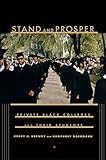Stand and Prosper : Private Black Colleges and Their Students / Henry N. Drewry, Humphrey Doermann.
Material type: TextPublisher: Princeton, NJ : Princeton University Press, [2012]Copyright date: ©2001Edition: Core TextbookDescription: 1 online resource (368 p.) : 62 tables. 2 line illusContent type:
TextPublisher: Princeton, NJ : Princeton University Press, [2012]Copyright date: ©2001Edition: Core TextbookDescription: 1 online resource (368 p.) : 62 tables. 2 line illusContent type: - 9780691116327
- 9781400843176
- 378.6
- LA1503
- online - DeGruyter
- Issued also in print.
| Item type | Current library | Call number | URL | Status | Notes | Barcode | |
|---|---|---|---|---|---|---|---|
 eBook
eBook
|
Biblioteca "Angelicum" Pont. Univ. S.Tommaso d'Aquino Nuvola online | online - DeGruyter (Browse shelf(Opens below)) | Online access | Not for loan (Accesso limitato) | Accesso per gli utenti autorizzati / Access for authorized users | (dgr)9781400843176 |
Frontmatter -- Contents -- Figures -- Tables -- Foreword -- Preface -- Acknowledgments -- Chapter 1. Panorama -- Chapter 2. Major Historical Factors Influencing Black Higher Education -- Chapter 3. The Beginnings of Black Higher Education -- Chapter 4. Public Schools, High Schools, Normal Schools, and Colleges -- Chapter 5. Curriculum -- Chapter 6. Higher Education in a New Century -- Chapter 7. Two Decades of Desegregation -- Chapter 8. Talladega College: A Case History (1867 to 1975) -- Chapter 9. Leadership and Luck -- Chapter 10. The Graduates -- Chapter 11. The Students -- Chapter 12. Faculty: Challenge and Response -- Chapter 13. The Small Colleges -- Chapter 14. Student Aid -- Chapter 15. External Sources of Support -- Chapter 16. Leadership and Financial Independence -- Chapter 17. Stand and Prosper -- Notes -- References -- Index
restricted access online access with authorization star
http://purl.org/coar/access_right/c_16ec
Stand and Prosper is the first authoritative history in decades of black colleges and universities in America. It tells the story of educational institutions that offered, and continue to offer, African Americans a unique opportunity to transcend the legacy of slavery while also bearing its burden. Henry Drewry and Humphrey Doermann present an up-to-date and comprehensive assessment of their past, present, and possible future. Black colleges fully got off the ground only after the Civil War--more than two centuries after higher education formally began in British North America. Despite horrendous obstacles, they survived and even proliferated until well past the mid-twentieth century. As the authors show, however, the 1954 U.S. Supreme Court ruling in Brown v. Board of Education brought them to a crucial juncture. While validating the rights of blacks to pursue opportunities outside racial and class lines, it drew the future of these institutions into doubt. By the mid-1970s black colleges competed with other colleges for black students--a welcome expansion of choices for African-American youth but a huge recruitment challenge for black colleges. The book gradually narrows its focus from a general history to a look at the development of forty-five private black colleges in recent decades. It describes their varied responses to the changes of the last half-century and documents their influence in the development of the black middle class. The authors underscore the vital importance of government in supporting these institutions, from the Freedman's Bureau during Reconstruction to federal aid in our own time. Stand and Prosper offers a fascinating portrait of the distinctive place black colleges and universities have occupied in American history as crucibles of black culture, and of the formidable obstacles they must surmount if they are to continue fulfilling this important role.
Issued also in print.
Mode of access: Internet via World Wide Web.
In English.
Description based on online resource; title from PDF title page (publisher's Web site, viewed 29. Jul 2021)


